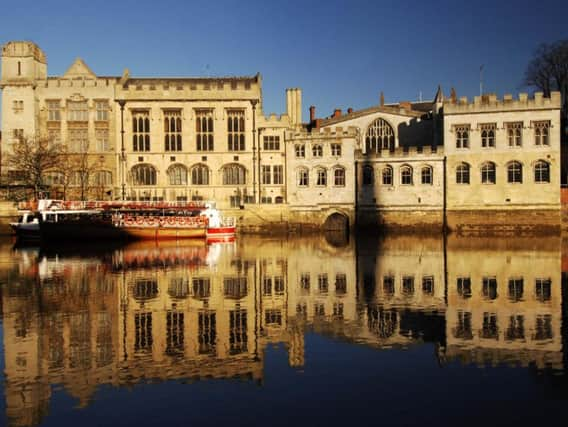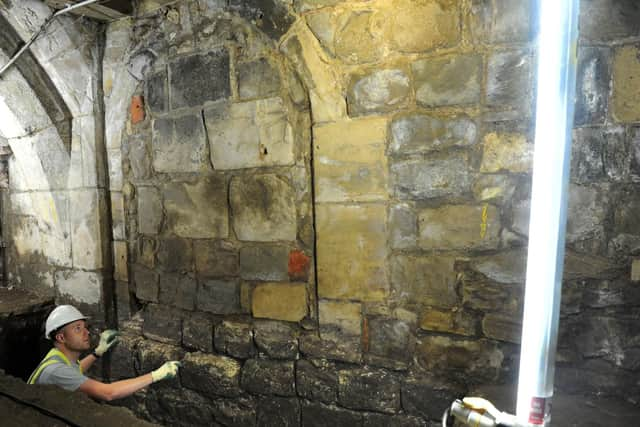Historic England want a secret underground passage beneath York's Guildhall to be opened to the public


The 15th-century Guildhall was built over a medieval road that led to and from the Ouse wharves. Common Hall Lane remains beneath the building as an enclosed passageway prone to flooding, but historians believe it was laid on top of what was originally a Roman route.
A wooden door hides the entrance to the passage, which is likely to be where stone used to build York Minster was landed after arriving by river, and there is a gated archway at the other end, just above the water line.
Advertisement
Hide AdAdvertisement
Hide AdThe public right of way beside the Guildhall that replaced the pathway was in use until 1884, when it was sealed off to allow the new post office to be built.


"Common Hall Lane is a brilliant story. It forms a direct line from Stonegate, the principal Roman road, down to the river. The stone used to build the Minster was probably landed there. You can easily walk past the wooden door without noticing it," said Neil Redfern, Historic England's inspector of ancient monuments.
"If you go to North Street Gardens, on the far bank, and look back across, you can see the door at the other end on the riverside frontage."
Advertisement
Hide AdAdvertisement
Hide AdIt's not the only secret hidden within the Guildhall. There are two passages with entrances that are concealed behind oak panelling in a committee room, one leading to a staircase and another meeting room, the other to the roof.
The Guildhall is currently undergoing major restoration work overseen by City of York Council, and Historic England have approached the project directors to ask whether public access to Common Hall Lane could be introduced when the building re-opens.
However, the council responded by stating that funds were not available to develop Common Hall Lane, and that a bid for financial support in 2015 had failed.
The safety upgrades needed to make the passage accessible - it is currently slippery and poorly lit - meant that costs were prohibitive.
Advertisement
Hide AdAdvertisement
Hide AdThere is occasional access permitted for special events, but this is limited to small groups in controlled conditions.
The restoration of the Guildhall will instead focus on making it commercially viable - new office space and a restaurant will be added.
The council's assistant director of regeneration and asset management Tracy Carter said:-
“The opening up of Common Hall Lane was part of an unsuccessful bid to the Heritage Lottery Fund in 2015 and is regrettably not part of the current scheme. The future possibility of restoring and opening up this fascinating historic entry point into the city may be considered in the future if funding is available.
Advertisement
Hide AdAdvertisement
Hide Ad"The ongoing restoration of the Guildhall is reviving the site's business, civic and social role in the city and will provide greater public access to this historic collection of buildings through events, a cafe and riverside restaurant. ”
The Guildhall was built in the 15th century as a meeting place for the city's guilds. King Richard III and the husband of Queen Victoria, Prince Albert, are among the dignitaries who have attended banquets there. The £200,000 ransom paid for King Charles I's release during the Civil War was counted inside the Guildhall.
The interior of the building was destroyed in an air raid in 1942, and it was rebuilt and restored in the 1950s. It has since been used as council chambers.
As part of the current construction work, materials and equipment have arrived at the site by barge, and unloaded by the Common Hall Lane entrance. The decision to use the river to transport goods is a nod to the Ouse's past, when it was heavily used for freight transit.
Advertisement
Hide AdAdvertisement
Hide AdWhen completed, the redeveloped Guildhall complex will have new office accommodation, community meeting spaces, a cafe and a riverside restaurant.
The work began last September as part of the council's blueprint to bring empty parts of the building back into use and improve public access.
Major repairs will also be undertaken on the structure, including stabilisation and damp-proofing.